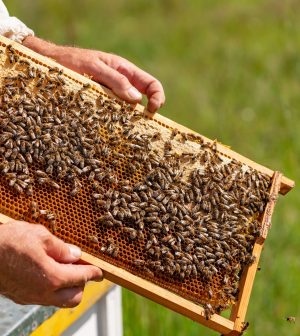- Navigating Your Midlife Crisis: Embracing New Possibilities
- City Raccoons Showing Signs of Domestication
- Mapping the Exposome: Science Broadens Focus to Environmental Disease Triggers
- One Week Less on Social Media Linked to Better Mental Health
- Your Brain Changes in Stages as You Age, Study Finds
- Some Suicide Victims Show No Typical Warning Signs, Study Finds
- ByHeart Formula Faces Lawsuits After Babies Sickened With Botulism
- Switch to Vegan Diet Could Cut Your Greenhouse Gas Emissions in Half
- Regular Bedtime Does Wonders for Blood Pressure
- Dining Alone Could Mean Worse Nutrition for Seniors
Warmer Autumns May Doom Hardworking Honey Bees

Honey bees fly to flowers whenever the weather is right, and warmer autumns and winters are putting these crop pollinators at risk, researchers warn.
Using climate and bee population models, a Washington State University team showed that longer and longer autumns with ideal flying weather increase the odds that bee colonies will collapse come spring.
“It’s not like this is something that can be expected 80 years from now,” lead author Kirti Rajagopalan, an assistant professor of biological systems engineering, said in a WSU news release. “It is a more immediate impact that needs to be planned for.”
A potential intervention: Putting colonies into cold storage, where bees will cluster in their hive from October to April before too many workers wear out. The practice is relatively new.
But commercial beekeepers already rely on it to help manage logistics of moving more than 2 million hives from around the country to pollinate almond trees in California, researchers said.
“A lot of beekeepers are already practicing this management technique of storing bees indoors because it has a lot of immediate potential to help in a number of ways,” study co-author Brandon Hopkins, a WSU entomologist, said in the news release.
He said the new study demonstrates that cold-storage has additional benefits for the survival of bee colonies in a changing climate.
For the study, researchers used simulations of climate projections for the years 2050 and 2100.
The simulations showed that bee colonies in many parts of the Pacific Northwest would likely experience spring collapses in both scenarios. This also occurred when researchers simulated climate change continuing at its present pace and when they looked at greenhouse gas reductions in the near future.
The upshot: Colonies wintering outside in colder areas like Omak, Wash., near Canada, might do OK.
But bee populations in many other places, like Richland, Wash., near the Oregon border, would plummet. Warmer winters would slash their adult populations to fewer than 9,000 by 2050 and under 5,000 by the turn of the century, according to the study.
Researchers said their models were “fairly conservative,” looking at seasonal factors like temperature, wind and amount of daylight.
“Our simulations are showing that even if there is no nutritional stress, no pathogens, no pesticides — just the conditions in fall and winter are enough to compromise the age structure of a colony,” said co-author Gloria DeGrandi-Hoffman, a research leader at the U.S. Department of Agriculture’s Carl Hayden Bee Research Center.
Researchers also simulated what might happen if honey bee hive boxes were placed in cold storage.
In the Richland simulation, by the year 2100, putting bees in cold storage from October to April would boost the spring population to more 15,000. If they stayed outside, the hives would total between 5,000 to 8,000, researchers said.
The findings were published March 25 in the journal Scientific Reports.
More information
Learn more about the risks facing honeybees at the Bee Conservancy.
SOURCE: Washington State University, news release, March 25, 2024
Source: HealthDay
Copyright © 2025 HealthDay. All rights reserved.










